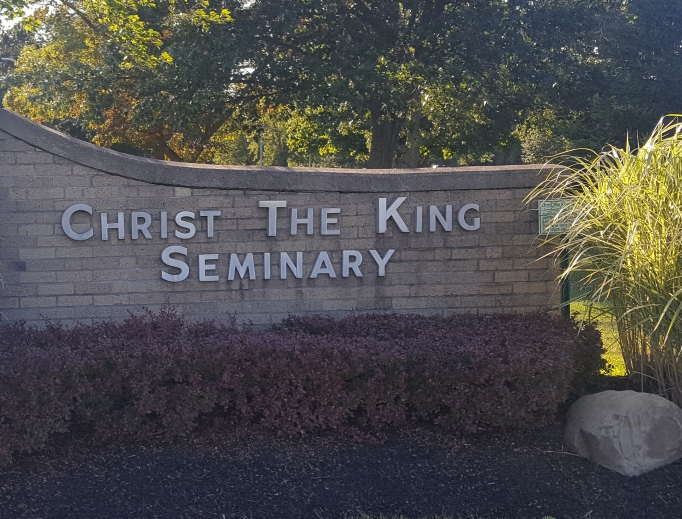Buffalo Seminary Closure Speaks Volumes to Other Dioceses
COMMENTARY: The decision removes a source of toxins that the seminary injected in the life of the local Church.

The closure of Christ the King Seminary in Buffalo, New York, is sad news, insofar as it is always sad when an institution is no longer capable of doing what it was founded to do. But Christ the King stopped doing that a very long time ago, and so its closure is also welcome news.
It staunches the financial bleeding for the diocese, as the seminary ran an annual deficit of $500,000 a year. That was the main reason offered for its closing, as Buffalo seeks to recover its footing after the resignation of its bishop and in the face of a new wave of sexual abuse lawsuits.
But to vary the medical metaphor, the closure also removes a source of toxins that the seminary injected in the life of the local Church.
There will be laments — many of them sincere — for the closure of Christ the King. Certainly, over many decades there was some good accomplished there and many priests look back on their time there with fondness. Yet on balance the preservation of Christ the King as an institution was a mistake. Therein lies a tale for other dioceses.
Christ the King was not unusual among seminaries in falling into a period of doctrinal confusion and/or moral corruption in the 1970s and 1980s. It was a widespread problem in the Church, in diocesan seminaries and even more so in religious houses. Yet many of them began a slow process of reform in the 1990s, rooting out doctrinal dissent in teaching and demanding virtuous behavior of both faculty and seminarians.
Christ the King somehow missed out on that reform stage, as has been covered recently in the Register. As scandals swirled around Buffalo these past two years, Christ the King was often at the center. Faculty were accused by seminarians of hosting raunchy gatherings. At one point, Bishop Richard Malone himself asked his staff about how a particular priest — a “sick puppy” in his characterization — ever was approved for Holy Orders by the seminary.
A seminary that has lost its way is not just a missed opportunity but an active threat to the health of a diocese — or dioceses, if it educates men from other places as well. Once ordained, it is difficult, but possible, to fill in gaps in a new priest’s formation. But if the seminary experience has actually deformed him in some way, it is near impossible to correct it later. False theological ideas, dubious pastoral practices, moral corruption — all this sits like a malignant tumor in the body of the local Church.
A wayward seminary can also be lethal for priestly vocations. It is quite possible that a seminary can strangle more priestly vocations than it nurtures. Men who are generously seeking to give their lives to Christ and his Church can find themselves scandalized and even destabilized by a corrupt seminary. It is not surprising when they leave and, feeling bewildered and betrayed by the Church, set aside the priestly vocation altogether.
Reform of a seminary is not an impossible task, but it is a difficult task. The formation faculty is relatively easy to replace, as those priests are usually appointed and removed by the local bishop or governing board. Academic faculty are more difficult to replace, as they often have some sort of tenure. If the seminary does not have its own academic faculty but relies on another university, it may have no say whatsoever on the faculty.
The difficult task of reform at Christ the King was not attempted over the last 25 years, even as other seminaries followed that path. As faculty and seminarians changed, the quality of its formation would wax and wane, but a thoroughgoing reform was never completed. Bishop Malone was only the most recent of several bishops not to do what needed to be done.
So where does that leave the diocese now? Better off financially without a doubt. But also pastorally. It is far, far better not to have a seminary than to have a flawed local one that needs to be propped up. Christ the King has 26 seminarians, 15 of which are for Buffalo and the remainder from other dioceses. Those men can now be sent to other, good quality seminaries.
There is another benefit. A local seminary, even a good one, always plays a role in confirming the local status quo. If all the priests in a diocese have gone to the same seminary, all formed by priests who themselves went to that seminary, then there is a perpetual bias in favor of how things have always been done. If the diocese and presbyterate are healthy, then that it not a problem, though complacency can set in. But if the diocesan and priestly culture is deficient, then the local seminary perpetuates that which needs to be changed.
Given the sad state of the Buffalo Diocese, a change in culture is needed. Sending their men to seminaries outside the diocese may contribute toward that.
The amputation of a seminary from the body of a local Church is indeed traumatic and regrettable. But even worse is maintaining a diseased limb.
Father Raymond J. de Souza is the editor in chief of Convivium magazine.
- Keywords:
- bishop malone
- bishop scharfenberger
- christ the king seminary closes
- father raymond de souza

















